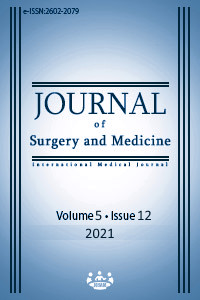Fragmented QRS and blood pressure pattern in normotensive individuals with a history of preeclampsia
Keywords:
Preeclampsia, Fragmentation, Electrocardiography, Holter, Blood pressureAbstract
Background/Aim: Hypertension is well defined in preeclamptic individuals and those with a history of preeclampsia. However, the relationship between blood pressure pattern and fragmented QRS on electrocardiography (ECG) has not been elucidated in normotensive patients with a history of preeclampsia. This study aimed to investigate the frequency of non-dipper blood pressure (BP) patterns in normotensive individuals with a history of preeclampsia and to evaluate the relevance of this pattern to fragmented QRS (fQRS). Methods: Sixty-three normotensive (office BP measurement) patients with a history of preeclampsia were included in this study between August 2020 and January 2021. These individuals underwent 24-hour ambulatory BP monitoring. The patients were divided into two groups as dipper and non-dipper, according to their BP patterns. The two groups were compared in terms of echocardiographic parameters, laboratory values, and QRS fragmentation on ECG. Results: Left ventricular diastolic dysfunction (LVDD) diagnosed by echocardiography (P= 0.015) and fQRS on ECG (P=0.002) were significantly higher in the non-dipper group than in the dipper group. Tricuspid regurgitation velocity (P=0.004) and average E/e' ratio (P<0.001) were higher in the non-dipper group. Mitral E/A ratio (P=0.437) and left atrial volume index (P=0.439) were similar between the two groups in echocardiography. The fQRS, LVDD, triglyceride, and low-density lipoprotein were subjected to multivariate logistic regression analysis, and fQRS was found to be an independent predictor of the non-dipper BP pattern in women with a history of preeclampsia (P=0.023, OR=4.951, 95% CI:1.245-19.688). Conclusion: The presence of an fQRS pattern on the ECG is associated with a non-dipper BP pattern in normotensive individuals with a history of preeclampsia.
Downloads
References
Atadağ Y, Aydın A, Kaya D, Öksüz A, Köşker HD. Risk assessments, pregnancy and birth processes of pregnant women at primary health care center: A retrospective study. J Surg Med. 2017;1(1):5-8.
Filipek A, Jurewicz E. Preeklampsja – choroba kobiet w ciąży [Preeclampsia - a disease of pregnant women]. Postepy Biochem. 2018 Dec 29;64(4):232-29. doi: 10.18388/pb.2018_146
McDonald SD, Malinowski A, Zhou Q, Yusuf S, Devereaux PJ. Cardiovascular sequelae of preeclampsia/eclampsia: a systematic review and meta-analyses. Am Heart J. 2008 Nov;156(5):918-30.
Tigen K, Karaahmet T, Fotbolcu H, Gürel E, Cevik C, Gecmen C, et al. The influence of dipper and nondipper blood pressure patterns on left ventricular functions in hypertensive patients: a tissue Doppler study. Turk Kardiyol Dern Ars. 2009;37(2):101-6. PMID: 19404031
Sánchez-Aranguren LC, Prada CE, Riaño-Medina CE, Lopez M. Endothelial dysfunction and preeclampsia: role of oxidative stress. Front Physiol. 2014 Oct 10;5:372.
Staff AC, Dechend R, Pijnenborg R. Learning from the placenta: acute atherosis and vascular remodeling in preeclampsia-novel aspects for atherosclerosis and future cardiovascular health. Hypertension. 2010 Dec;56(6):1026-34.
Eyuboglu M. Fragmented QRS as a Marker of Myocardial Fibrosis in Hypertension: a Systematic Review. Curr Hypertens Rep. 2019 Aug 26;21(10):73.
Tanriverdi Z, Eyuboglu M, Bingol Tanriverdi T, Nurdag A, Demirbag R. The relationship between fragmented QRS and non-dipper status in hypertensive patients without left ventricular hypertrophy. Clin Exp Hypertens. 2017;39(7):680-4.
Zhang R, Chen S, Zhao Q, Sun M, Yu B, Hou J. Fragmented QRS complex is a prognostic marker of microvascular reperfusion and changes in LV function occur in patients with ST elevation myocardial infarction who underwent primary percutaneous coronary intervention. Exp Ther Med. 2017 Jun;13(6):3231-3238.
Diehl CL, Brost BC, Hogan MC, Elesber AA, Offord KP, Turner ST, Garovic VD. Preeclampsia as a risk factor for cardiovascular disease later in life: validation of a preeclampsia questionnaire. Am J Obstet Gynecol. 2008 May;198(5):e11-3.
Verdecchia P, Porcellati C, Schillaci G, Borgioni C, Ciucci A, Battistelli M, et al. Ambulatory blood pressure. An independent predictor of prognosis in essential hypertension. Hypertension. 1994 Dec;24(6):793-801.
Hoshide S, Kario K, Hoshide Y, Umeda Y, Hashimoto T, Kunii O, et al. Associations between nondipping of nocturnal blood pressure decrease and cardiovascular target organ damage in strictly selected community-dwelling normotensives. Am J Hypertens. 2003 Jun;16(6):434-8.
Rodrigues TC, Canani LH, Viatroski RS, Hoffmann LH, Esteves JF, Gross JL. Masked hypertension, nocturnal blood pressure and retinopathy in normotensive patients with type 1 diabetes. Diabetes Res Clin Pract. 2010 Feb;87(2):240-5.
Das MK, Khan B, Jacob S, Kumar A, Mahenthiran J. Significance of a fragmented QRS complex versus a Q wave in patients with coronary artery disease. Circulation. 2006 May 30;113(21):2495-501.
Eyuboglu M, Akdeniz B. Association Between Non-Dipping and Fragmented QRS Complexes in Prehypertensive Patients. Arq Bras Cardiol. 2019 Jan;112(1):59-64.
Maurer MS, Spevack D, Burkhoff D, Kronzon I. Diastolic dysfunction: can it be diagnosed by Doppler echocardiography? J Am Coll Cardiol. 2004 Oct 19;44(8):1543-9.
Muthyala T, Mehrotra S, Sikka P, Suri V. Maternal Cardiac Diastolic Dysfunction by Doppler Echocardiography in Women with Preeclampsia. J Clin Diagn Res. 2016 Aug;10(8):QC01-3.
Downloads
- 183 286
Published
Issue
Section
How to Cite
License
Copyright (c) 2021 Kemal Göçer, Ekrem Aksu, Ugurkan Erkayıran
This work is licensed under a Creative Commons Attribution-NonCommercial-NoDerivatives 4.0 International License.
















